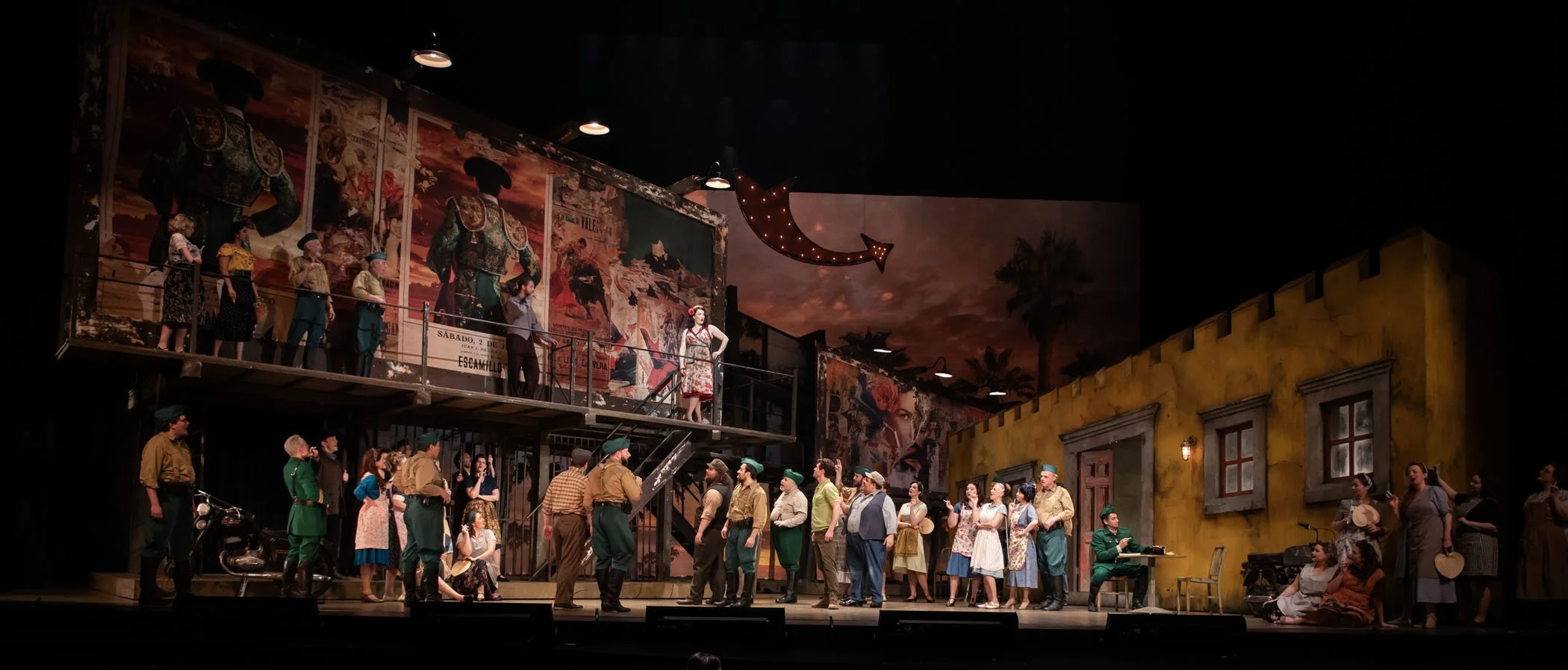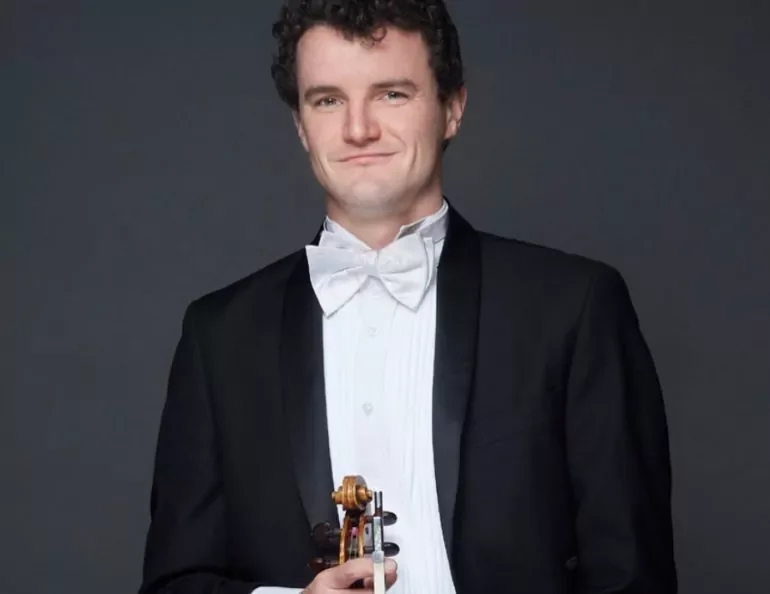Music review: Striking sets and vintage-postwar touches give Vancouver Opera's Carmen a vivid visual world
Bold staging and some standout singing please a sellout house, while breathing new life into crowd favourite
Vancouver Opera’s Carmen, with Latin American-flavoured sets from Opera Philadelphia. Photo by Emily Cooper
Vancouver Opera presents Carmen again on May 2, 4, and 5
CARMEN IS NORMALLY all about the music—a nonstop hit parade whose instantly recognizable songs have been picked up everywhere from The Muppets to vintage commercials from B.C.’s Palm Dairy. But when it comes to Vancouver Opera’s new production, let’s start with its stunning visual statement—sets and costumes that lift Georges Bizet’s ultra-famous work out of dusty Spanish exoticism and into a grittier, Latin American-feeling world of the postwar early ’50s.
Originally created for Opera Philadelphia by Gerry McCann, the monumental sets feature peeling billboards that advertise bullfights and faded pink- and yellow-plaster colonial houses that recall Havana or Mérida—that vibe enhanced by palm trees silhouetted against an orangey-sunset sky. When Carmen sings her iconic seductive “Habanera”, that sky magically switches from golden daylight to sultry, dusky purple.
The design morphs dramatically from scene to scene, its exaggerated perspective most striking in the third act, where the stage becomes a cavernous industrial warehouse for Carmen’s smuggling gang.
The costumes play vividly against the collage-like streetscapes: an early scene of the cigarette-factory women streaming out in their vintage-print aprons is gorgeous; later, bullfighters in bright finery parade beneath glittering confetti. In an inspired stroke, Escamillo’s adored toreador spends his off-ring hours looking like a motorcycle-riding, Marlon Brando-esque screen star.
In short, there’s style to burn—quite literally, as everyone smokes a near-comical amount of cigarettes.
Like VO general director Tom Wright said off the top of this production, “Opera is expensive.” And we’ve been lucky in 2024 to already have seen two elaborately designed operas—the last one being the groovy-’60s-Rome, neon-green-cat-bedecked Don Pasquale. It’s not just about eye candy, though. In practical terms, this Carmen’s forced perspective helps contain and arrange the massive chorus and cast. On an aesthetic level, the sets add multilayered depth, variety, and interest; between scenes, the billboards rotate ingeniously to become the scaffolding of a bull ring. On a larger level, the design—like other parts of this production—breathes new life into one of opera’s warhorses.
The characterizations feel equally fresh. Bizet’s story centres on the Roma femme fatale Carmen, who seduces naive soldier Don José into abandoning his post and helping her smuggling ring, before tossing him over for a bullfighter—sending her ex into a murderous rage. Here, Carmen, rather than a simple seductress, feels more complex and empowered than usual. On opening night, American mezzo soprano Sarah Mesko, who alternates with Ginger Costa-Jackson, brought both sizzle and strength to the role—not to mention a smouldering, richly hued voice.
Her character is carved out most strikingly in the final act, when an obsessed Don Jose crawls up her skirt to beg Carmen to take him back, and she pushes him forcefully to the ground. Later, he rips off her dress’s flamenco ruffle while she remains defiant. Staging the scene, director Rachel Peake emphasizes the ugliness of the violence in all its gender dynamics—death as the ultimate act of control over a woman who can’t be controlled.
Although his initial chemistry with Carmen could have been cranked up, Alok Kumar, who has a beautiful, technically assured tenor, develops an intriguing instability as Don José, his voice’s vibrato quality reinforcing his emotional fragility. (He alternates the role with Matthew White.) As ever, his character can’t compete with the toreador Escamillo—Nathan Keoughan having a blast ripping into the role.
The production’s biggest surprise—although not if you caught her as Helena in the VO’s A Midsummer Night’s Dream last fall—is Jonelle Sills as Micäela. She finds depth and resolve in Bizet’s virginal, goody-goody foil to fiery Carmen. That’s in part because her rich, luminous soprano simply commands the stage—especially as she gains strength in her aria (“Je dis que rien ne m’épouvante”). Carmen also has a standout “Card Trio” with strong Young Artist Program singers Heidi Duncan and Simran Claire as her gal pals. Innovative, well-integrated choreography by Cydney Uffindell-Phillips helps keep the opera moving between the stop-start of the opéra-comique form’s spoken and singing parts.
Jonelle Sills’s Micäela and Alok Kumar’s Don José in Vancouver Opera’s Carmen. Photo by Emily Cooper
A strong chorus, amped up with a child’s ensemble, delivers some lovely layered singing, particularly in the “Les voici! Voici la quadrille!”, spread across the stage. And under the baton of Leslie Dala, the Vancouver Opera Orchestra is beautifully modulated with the singing. The highlight is the “Aragonaise” opening Act IV’s toreador pageantry, the ensemble finding every nuance in its rat-tat-tatting tambourine, heady woodwinds, and fluid strings.
Carmen is an iconic crowd pleaser, which is why it’s one of the most performed operas in the world, why it is the highest-grossing production in VO history—and why it carries big expectations. As for why this production pleases? It more than meets those expectations while delivering striking and provocative new surprises, visual and otherwise. ![]()














